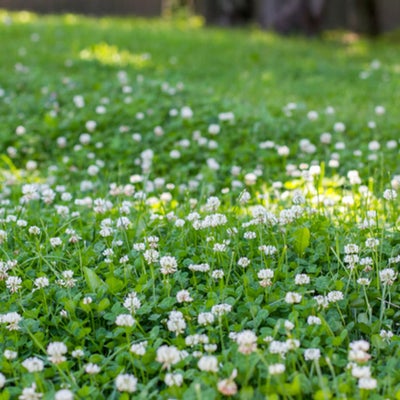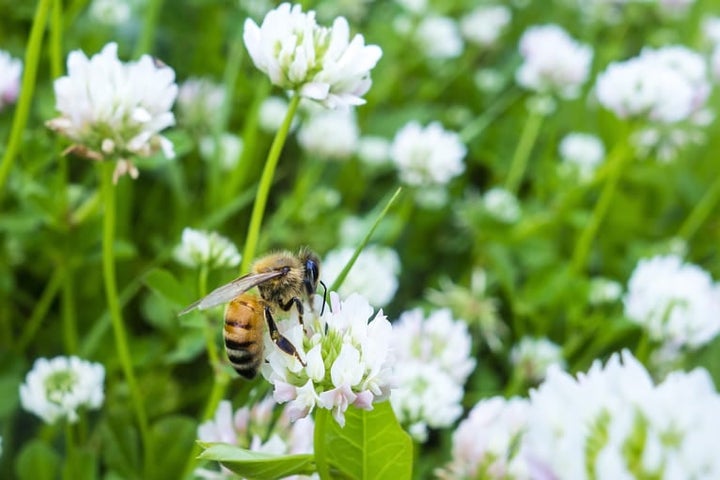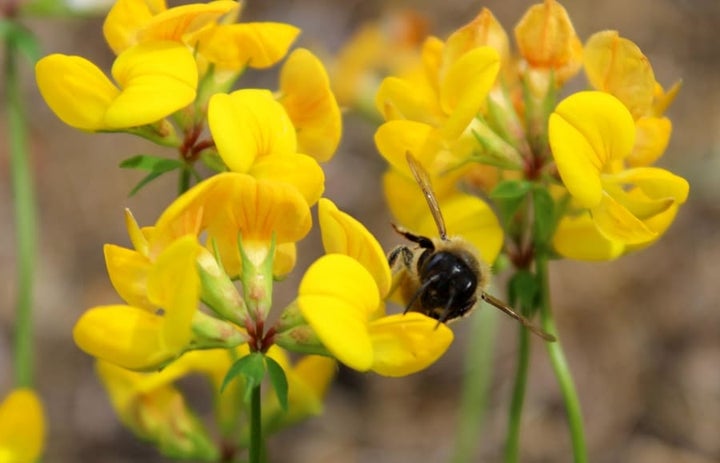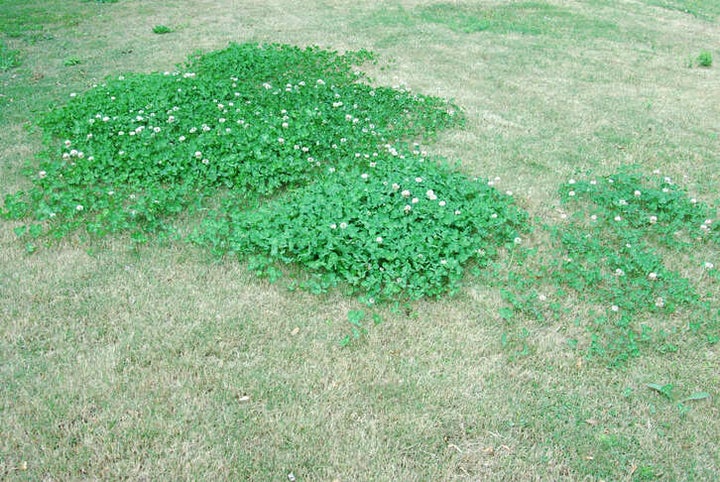
Quick facts
Clovers and clover-like plants (trefoils and medicks) are members of the pea family (Fabaceae)
White clover, red clover, hare’s foot clover, lesser trefoil, slender trefoil, bird’s foot trefoil and black medick are native to the UK
Clover flowers provide nectar for bees and butterflies
If you need to control clovers, trefoils and medicks, non-chemical methods are effective
What does clover look like?
Several species of clover and clover-like plants (trefoils and medicks) are low-growing and commonly found in lawns. At a glance, their leaves look similar but it is possible to tell them apart, especially when in flower. The descriptions and images below will help you identify some common species:
White clover (Trifolium repens) is a creeping perennial able to produce roots at growing points along its stems. It can grow to a height of 45cm (18in) but is often much shorter in lawns. Leaves are usually trifoliate (having three leaflets) but may have four leaflets – if you're lucky! Leaflets have rounded tips, often with a white mark. The flowers are creamy-white, sometimes with a hint of pale pink, and appear from May to October.
Red clover (Trifolium pratense) is a perennial that can grow 60cm (2ft) tall. It is not common in closely mown lawns but grows well in long grass and meadows. The leaves are trifoliate and leaflets are oval with a distinctive, pale V-shaped mark. The pinkish-red flowers appear from May to October and are great for pollinators, making it a good choice for a wildlflower meadow.
Lesser trefoil (Trifolium dubium) is a low growing annual, able to reach 25cm (10in) in height but is usually shorter. In lawns it forms a flattened, roughly circular mat of thin, wiry stems. Trifoliate leaves have oval leaflets. The compact flowers are yellow and appear from May to October.
Hare’s foot clover (Trifolium arvense) is a low growing annual, usually shorter than 25cm (10in) when growing in lawns. Its stems and trifoliate leaves, with narrow leaflets, are covered in soft hairs. The pale pink flowers, produced from June to September, are also covered in silky white hairs, giving the whole plant a soft, fluffy appearance.
Bird’s foot trefoil (Lotus corniculatus) is a perennial with a sprawling habit up to 20cm (8in) in height. Leaves consist of five leaflets, with one pair of leaflets near the base of the leaf stalk and the other three at the tip. Reddish buds open to yellow flowers from May to October. Its long, thin seedpods are quite distinctive.
Black medick (Medicago lupulina) is a low-growing annual or short-lived perennial, reaching about 20cm (8in) in height with stems forming a low mat in lawns. Its leaves are trifoliate, with a tiny point at the tip of each leaflet. Rounded, yellow flowerheads from April to October are followed by black seedpods.
Slender trefoil (Trifolium micranthum) is a low growing annual, similar to lesser trefoil but smaller in stature, generally growing to less than 10cm (4in) in height. The trifoliate leaves have short stalks. Small yellow flowers appear during summer.

Distinguishing between the clovers in your lawn isn’t essential, as they can all be controlled using the same methods, if required. If you’re an RHS member and are unsure of what type of clover, trefoil or medick is growing in your garden, you can use the RHS Gardening Advice service to get your plants identified.
Did you know?
Occasionally a variant of clover with four leaflets will occur. Genetic and environmental factors bring about this change. For centuries, four-leaved clovers have been heaped in superstitions and myths. The leaves are said to represent faith, hope, love and luck, with the fourth leaf being for luck. This could be general good luck, or specific lucky powers, such as the ability to see fairies or find a suitable husband quickly.
Is clover a weed?
No – clovers and closely related trefoils and medicks are wildflowers, ideal for flower-rich lawns and meadows. Their flowers attract beneficial insects and are a valuable source of nectar for bees.


As they are drought tolerant and able to produce their own nitrogen, clovers, trefoils and medicks don't need irrigation or applications of fertiliser to stay green and healthy. And, as they can cope with some foot traffic, clovers make an excellent alternative to lawn grass species, particularly on poor, dry soils.
Some gardeners have fully embraced the benefits of clover and have re-seeded lawns with white clover, using dwarf agricultural cultivars or strains, such as ‘Kent Wild White’. Clover lawns are a far more sustainable and environmentally friendly alternative to labour and resource intensive fine lawns.

However, gardeners wanting fine turf or a domestic lawn containing only lawn grass species will likely consider clovers, trefoils and medicks to be weeds.
What is a weed?
The term ‘weed’ describes a plant that is growing where it isn’t wanted. Weeds usually thrive in average garden conditions, reproducing and spreading easily. It is up to you to decide what you call a weed and what you choose to retain or remove.
Frequently asked questions about controlling clover in lawns
Here are our answers to your most common questions about dealing with clover growing in lawns:
How invasive is clover in lawns?
Clovers, trefoils, and medicks spread by seed and these are likely to germinate if they land on bare soil. Perennial species, such as white clover and bird’s foot trefoil can also spread by stems or rhizomes (underground stems). Given favourable conditions, they can form large patches in lawns.
The good news is that clover doesn’t compete well with dense, healthy lawn grasses, so improving the health of your lawn is often all that is needed to control these plants, if desired.
Do I need to get rid of clover in my lawn?
No – allowing clovers, trefoils and medicks to grow in a wildflower or species-rich lawn is a great way to boost the biodiversity of your garden and gives you the chance to enjoy their attractive flowers. Even if you prefer to mow your lawn regularly, clovers are green and stay low if regularly cut, so there is no need to remove them.
However, if you prefer a perfectly manicured fine lawn, you’ll probably want to get rid of them.
Did you know?
Clovers are in the pea family (Fabaceae), and like nearly all the plants in this family, they can ‘fix’ nitrogen by forming a symbiotic (mutually beneficial) relationship with soil bacteria. The clovers provide the bacteria with energy, while the bacteria convert nitrogen gas into a form that plant roots can access to support healthy green growth.
What is the easiest way to kill clover growing in a lawn?
If you have clover growing in your lawn and it cannot be tolerated, there are a few methods of controlling it:
- Improve the health of your lawn – clovers, trefoils and medicks are less able to establish in dense, healthy grass. Follow a programme of lawn maintenance in spring/summer and autumn to boost the vigour of your lawn.
- Pull or fork out plants– grasp the sprawling stems together and pull out to remove the roots. Where soil is compacted or plants are well-established, insert a hand fork under rooted sections of stem and the main plant to lift out the roots. This is a good, easy option for quick results on small areas of lawn. If this leaves patches of bare soil, re-seed in spring or autumn.
- Rake before mowing – rake over areas containing clovers, trefoils and medicks to lift the stems before mowing. This helps mowers remove more growth, weakening individual plants and preventing self-seeding. Make sure to rake up and remove clippings containing clover to stop plants shedding seed or re-rooting.
Should I use weedkiller?
No – clovers, trefoils and medicks are resistant to many selective lawn weedkillers. As non-chemical control methods are effective, even if time-consuming on large lawns, there is no need to use a weedkiller.
For more information, see our page on Weeds: non-chemical controls.















